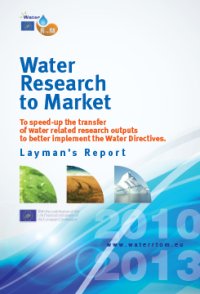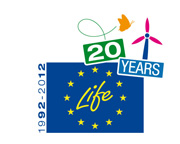APIFLOT
| Output characterisation | |
| OUTPUT SENTENCE | A wastewater treatment equipment with high efficiency, very compact, which can solve the problem of heavily loaded wastewaters. |
| OUTPUT TYPE | prototype |
| WATER TOPIC | Urban pollution |
| KEYWORDS | surface water and groundwater, Urban pollution, Industrial pollution, Agricultural pollution |
| KEYWORDS TYPE | Prototype - Equipment (Dissolved air flotation (DA |
| MARKET NEED TAILORED | Water Framework Directive; Wastewater Directives - Quality of the effluent |
| OUTPUT DESCRIPTION | Wastewater treatment equipment with high efficiency, very compact, which can solve the problem of heavily loaded wastewaters. It was conceived a dissolved air flotation unit. We wanted to reach the discharge parameters below the limits set by current Romanian regulations (NTPA 001), in an attempt to keep a clean environment. The dissolved air flotation unit consists of two separate devices: pressurized capsule and lamellar settling. The pressurized capsule is a cylindrical chamber provided at the ends with 2 caps. Inside the capsule there are inserted water and air under pressure. Water circuit is located at the top of the capsule and water is introduced with the help of 4 sprinklers. In this way, water is introduced as fine droplets dispersed and not as jet. The air supply is located at the bottom of the capsule. To obtain a longer time contact between air bubbles introduced through the circular pipe and the water, we have found the solution to introduce moving plastic elements inside the capsule. The decantation is made of two functional compartments arranged in series: a lamellar settler and a technical room. At the usual clarifiers, the settling plates can clog. In order to overcome this anticipated difficulty the merging of a flotation system will solve the problem. The two-phase mixture air-water enters the clarifier through a transport system that consists of pipes and three funnels. Funnels are diffusers (relaxation area for the compressed fluid). In this way, the mixture bubbles - water does not "wash" the slab foundation. Air bubbles rise to the free surface and become stuck in "light" suspended solids and lead them to the surface, where they are directed to skimmer and discharged from the system. |
| STATE OF DEVELOPMENT | Laboratory facility. |
| INNOVATIVE ASPECTS AND ADVANTAGES | The innovative aspects and the advantages of the dissolved air flotation unit are: - Process gives greater efficiency due to moving parts inside the capsule that "tease" trail of bubbles to the surface; - Through the use of sprinklers, water is sprayed in very fine droplets and is dispersed within the capsule, thus creating a large air-water contact surface; - Leads to a minimum area for settling facility; - Quick and easy installation even in existing clarifiers; - The treatment method provides greater efficiency without using any bio-products or consumables that enhance the biological degradation processes - completely organic process; - Modular construction; - No lamellar settling clogs because the air bubbles which "clean" the plates by their upward movement. |
| INTELLECTUAL/INDUSTRIAL PROPERTY RIGHTS | SC DFR Systems SRL has filed two patent requests: - Pressurized capsule for dissolved air flotation unit, no. A 00074/30.01.2011; - Final settler for dissolved air flotation unit, no. A 00073/30.01.2011. |
| TRANSFERABILITY | The unit was tested at laboratory scale, but according to the requirements of potential users, equipment can be designed for a larger scale. |
| POTENTIAL USERS/CLIENTS | As direct beneficiaries of the flotation unit can be identified: - Companies related to the food industry (slaughterhouses, meat and dairy producers, producers of alcohol, etc.) - Companies related to the pharmaceutical industry; - Companies related to the textile industry; - Companies who hold landfills and where the leachate is generated; - Local authorities (municipalities). Also the possibility of contracting new research projects, which will be based on the previous researches, exists. |
| BUSINNESS CASE | Yes |
| Estimation of risks | |
| EVALUATION OF RISKS FOR OUTPUT USERS | Not relevant; realization of a pilot installation is not complicated, and for launching it in production are not necessary expensive equipments. |
| ECONOMICAL RISKS | Not relevant; implementing solution for efficient wastewater treatment is compulsory by low in Romania. |
| TECHNICAL RISKS | Insufficient technical information about the site conditions. |
| MARKET RISKS | The project is addressed to an urgent necessity of our days, when the industrial wastewater is characterized by high concentrations of pollutants with a diverse chemical structure and stable over time. Researches were to develop a compact installation to |
| Steps ahead | |
| NEXT STEPS TO ACHIEVE THE STATUS 'READY TO USE' | As future research actions can only be specify additional tests to be carried for a flotation unit connected to a wastewater treatment plant. |
| TYPE OF PARTNER FOR THE NEXT DEVELOPMENTS | SMEs / Companies; Research institutes; Local authorities; Water companies etc. |
| TASKS TO BE PERFORMED | Potential research partners must assist us in designing and testing a pilot DAF unit. Potential beneficiaries of the flotation system must provide us information on the wastewater they want to treat (wastewater flow, wastewater quality parameters and the available land to carry out a wastewater treatment plant). |
| COLLABORATION DETAILS | Technical cooperation, assistance, trade agreement, production agreement, financing agreement to launch the DAF units production. |
| Estimation of ressources | |
| RESOURCES FOR NEXT STEPS | The design and the implementation of a pilot DAF unit can be made in about three months. To obtain reliable results on the level of treatment / effectiveness of the installation and operation / maintenance it is required a period of 6 months for experiments and analysis. |
| FORESEEN COSTS FOR NEXT STEPS |
|
| Contact | |
| TECHNICAL CONTACT | Gabriel PETRESCU |
| COUNTRY | ROMANIA |
| WEBSITE | www.dfr.ro |
| WATER RTOM CONTACT | CFPPDA |
| Background | |
| PROJECT NAME | THEORETICAL AND EXPERIMENTAL RESEARCHES IN ORDER TO DESIGN AN ADVANCED TREATMENT TECHNOLOGY (FLOTATION) FOR HEAVILY LOADED WASTEWATERS |
| PROJECT ACRONYM | APIFLOT |
| PROJECT DESCRIPTION | ?Wastewater treatment equipment with high efficiency, very compact, which can solve the problem of heavily loaded wastewaters. It was conceived a dissolved air flotation unit. We wanted to reach the discharge parameters below the limits set by current Romanian regulations (NTPA 001), in an attempt to keep a clean environment. ? ?The dissolved air flotation unit consists of two separate devices: pressurized capsule and lamellar settling. ?The pressurized capsule is a cylindrical chamber provided at the ends with 2 caps. Inside the capsule there are inserted water and air under pressure. Water circuit is located at the top of the capsule and water is introduced with the help of 4 sprinklers. In this way, water is introduced as fine droplets dispersed and not as jet. The air supply is located at the bottom of the capsule. To obtain a longer time contact between air bubbles introduced through the circular pipe and the water, we have found the solution to introduce moving plastic elements inside the capsule. ?The decantation is made of two functional compartments arranged in series: a lamellar settler and a technical room. At the usual clarifiers, the settling plates can clog. In order to overcome this anticipated difficulty the merging of a flotation system will solve the problem. The two-phase mixture air-water enters the clarifier through a transport system that consists of pipes and three funnels. Funnels are diffusers (relaxation area for the compressed fluid). In this way, the mixture bubbles - water does not "wash" the slab foundation. Air bubbles rise to the free surface and become stuck in "light" suspended solids and lead them to the surface, where they are directed to skimmer and discharged from the system. |
| LEADER | SC DFR Systems SRL |
| TEAMS INVOLVED | SC DFR Systems SRL ?University POLITEHNICA of Bucharest |
| COUNTRIES INVOLVED | ROMANIA |
| PROJECT LOCATION | RO |
| FUNDING ORGANISATION | Sectoral Operational Programme“INCREASE OF ECONOMIC COMPETITIVENESS“ |




